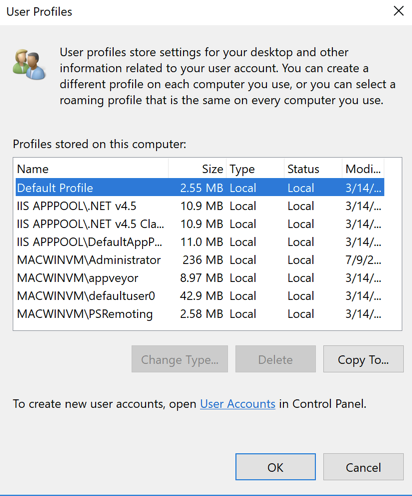A common pain point in an IT administrator’s career is user profiles. User profiles are a ubiquitous part of a Windows IT pro’s life; especially those that manage virtual desktop environments like Remote Desktop Services (RDS) or Citrix. In this post, I’m going to demonstrate a way you take out your aggression by using PowerShell to delete user profiles (and discover them).
系统管理员必须处理的问题包括:
- 损坏的用户注册表hive
- 需要在所有用户配置文件之间共享的文件
- 弄清如何重新创建损坏的配置文件
- …以及更多
曾经令人沮丧的经历现在通过PowerShell变得稍微不那么令人沮丧。以下是 PowerShell 可以使管理 Windows 用户配置文件变得更容易的几种方法。
使用 ManageEngine ADManager Plus 管理和报告 Active Directory、Exchange 和 Microsoft 365。 立即下载免费试用!
枚举用户配置文件
在单个 Windows 计算机的文件系统上查看用户配置文件很容易。只需查看C:\Users文件夹。但是,当您这样做时,您不仅没有获得完整的图片,而且由于潜在的文件系统访问问题,这也很麻烦。有一个更好的方法,那就是通过 WMI 或 CIM。在 CIM 中,存在一个称为Win32_UserProfile的类。该类包含机器上存在的所有配置文件以及许多其他有用信息,这是简单的文件系统文件夹所无法告诉您的。
使用 PowerShell,您可以使用Get-CimInstance命令访问此 CIM 类。
下面,我正在查找本地计算机上的第一个用户配置文件。您将注意到许多有用的信息,如LastUseTime、SID等。
Get-CimInstance cmdlet 不仅可以在本地工作,还可以远程工作。通过使用ComputerName参数,您可以指定 1、10 或 100 个不同的远程计算机,并且它将愉快地查询每一个。
删除用户配置文件
一旦您了解了如何在计算机上列举用户配置文件,您可以进一步删除这些用户配置文件。
I can’t count how many times I’ve had to delete user profiles because something got corrupted and I just needed the user to log in again and recreate it. At one time, I would simply have the user log off and remove the C:\Users<UserName> folder from the file system. Usually it works, sometimes it didn’t. What I didn’t realize was that I was actually leaving some remnants behind.
这样做的正确方式是通过 CIM 发起删除。
使用您刚刚查看的相同 CIM 类,不仅可以查看配置文件,还可以完全删除它们。这与进入系统设置下的用户配置文件框并点击删除按钮相同。

为此,再次枚举用户配置文件,并此次应用过滤器以选择要删除的单个用户配置文件。在这种情况下,删除名为UserA的用户配置文件。您可以使用 PowerShell 的Where-Object cmdlet 和一些字符串操作来从LocalPath属性中提取用户文件夹名称,如下所示。
一旦您能够缩小到单个配置文件,您可以将该 CIM 实例传递给 Remove-CimInstance cmdlet,以处理 Get-CimInstance 返回的每个对象。此过程将从文件系统和注册表中删除用户配置文件。
同样,如果您想要扩展到多台计算机,只需在 Get-CimInstance 上使用 ComputerName 参数即可。
使用 ManageEngine ADManager Plus 管理和报告 Active Directory、Exchange 和 Microsoft 365。下载免费试用版!
摘要
您现在已经看到了一个简单的枚举和删除 Windows 用户配置文件的方法。如果您不知道 CIM 类 Win32_UserProfile,您可能一直将 C:\Users\
您可以看到用户配置文件远不止是一个简单的文件系统文件夹。下次需要从您的环境中的 Windows 计算机查询或删除用户配置文件时,请使用 CIM。
Source:
https://adamtheautomator.com/powershell-delete-user-profile/













